Bringing a dog into your home can enrich family life with joy, companionship, and unconditional love. However, for families with allergy sufferers, the dream of a furry friend can often be complicated by pet dander. The good news is that many wonderful dog breeds are known for their low-shedding coats, making them excellent candidates for families seeking a less allergenic environment. These breeds, often referred to as “hypoallergenic,” can significantly reduce the amount of dander and hair in your home, allowing allergy-prone individuals to enjoy the company of a canine companion without constant sniffles or itchy eyes.
While no dog is 100% allergen-free—as all dogs produce some level of dander, saliva, and urine, which contain allergens—low-shedding breeds minimize the spread of these irritants. This guide will explore what makes a dog a good fit for families, focusing on breeds that are not only low-shedding but also possess temperaments ideal for living with children and integrating seamlessly into a bustling household. Discover the best non-shedding dog breeds that promise a harmonious home for everyone.
Understanding Low-Shedding and “Hypoallergenic” Dogs
The term “hypoallergenic” can sometimes be misleading. It doesn’t mean “no allergens,” but rather “fewer allergens.” Dogs typically shed their fur, releasing dander (tiny flakes of skin) into the environment. Dander, not the fur itself, is the primary trigger for most dog allergies. Low-shedding breeds retain their fur rather than shedding it frequently, which means less dander is released into the air and onto your furniture. This characteristic is what makes them a better choice for individuals sensitive to pet allergens.
These breeds often have hair-like coats that continuously grow, similar to human hair, requiring regular grooming to prevent matting and to remove loose hairs and dander before they can spread. Choosing a dog that doesn’t shed much is a critical step for families managing allergies, but it’s also a boon for general household cleanliness, reducing the constant battle against dog hair on floors and upholstery.
Why Low-Shedding Dogs are Great for Families
Beyond the allergy benefits, low-shedding dogs often come with other advantages that make them fantastic family pets. Many breeds in this category are highly intelligent, eager to please, and possess gentle temperaments, making them easier to train and more patient with children. Their diverse sizes and activity levels also mean there’s a low-shedding option for nearly every family dynamic, whether you live in a cozy apartment or a sprawling home with a large yard. For families who want a pet that is both loving and easy to maintain from a shedding perspective, these breeds offer a compelling choice.
You can explore more options for medium to large sized dogs that don’t shed and find the perfect fit for your family’s lifestyle.
Top Family-Friendly Dog Breeds That Don’t Shed
Here’s a detailed look at some of the best non-shedding dog breeds known for their wonderful family-friendly qualities:
1. Poodle (Standard, Miniature, Toy)
 A white Standard Poodle walks gracefully through green grass under a clear sky, showcasing its curly, low-shedding coat.
A white Standard Poodle walks gracefully through green grass under a clear sky, showcasing its curly, low-shedding coat.
Poodles are celebrated for their exceptional intelligence, elegant appearance, and, importantly for families, their non-shedding, curly coats. Available in three sizes—Standard, Miniature, and Toy—there’s a Poodle to fit almost any family and living situation. Standard Poodles, originally bred for hunting, are robust and active, making them great companions for adventurous families who enjoy outdoor activities. Miniature and Toy Poodles are equally intelligent and playful but require less space, adapting well to apartment living as long as they receive adequate exercise and mental stimulation. All Poodles are highly trainable, eager to please, and generally good with children, though early socialization is key. Their dense curls need regular brushing and professional grooming every 4-6 weeks to prevent matting.
2. Yorkshire Terrier
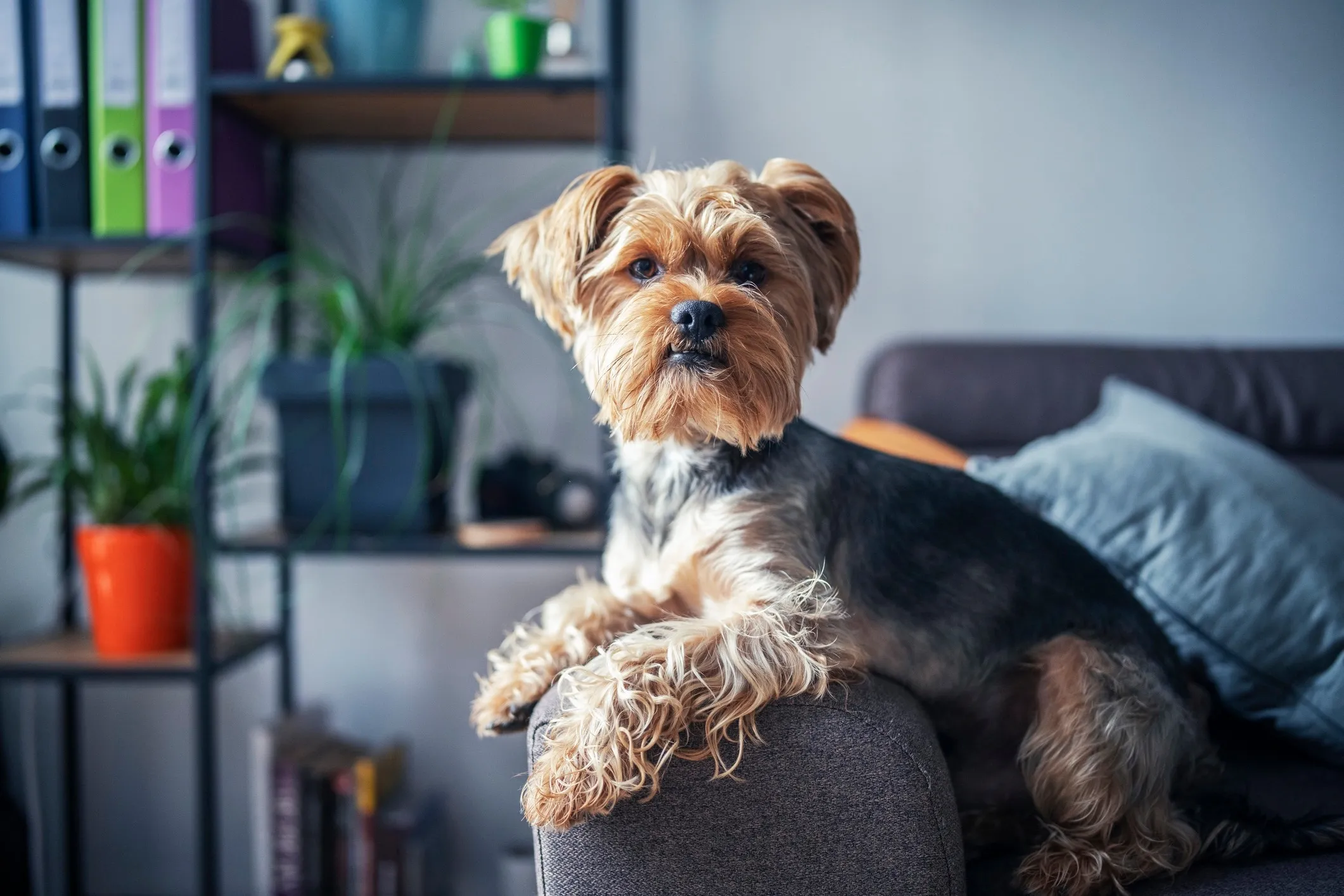 A blue and tan Yorkshire Terrier lounges comfortably on an armchair, looking alert and charming.
A blue and tan Yorkshire Terrier lounges comfortably on an armchair, looking alert and charming.
Affectionate, spunky, and charming, the Yorkshire Terrier is a small package with a big personality. Their long, silky, human-like hair sheds minimally, making them a great option for families with allergies. Yorkies are devoted to their families and thrive on attention. Despite their small size, they have a feisty terrier spirit and require consistent training and socialization. They are adaptable to various living spaces, including apartments, and their moderate exercise needs can be met with indoor play and short walks. Yorkies can be wonderful companions for families with older, respectful children who understand how to interact with small dogs. Regular grooming, including daily brushing, is essential to keep their coats tangle-free.
3. Shih Tzu
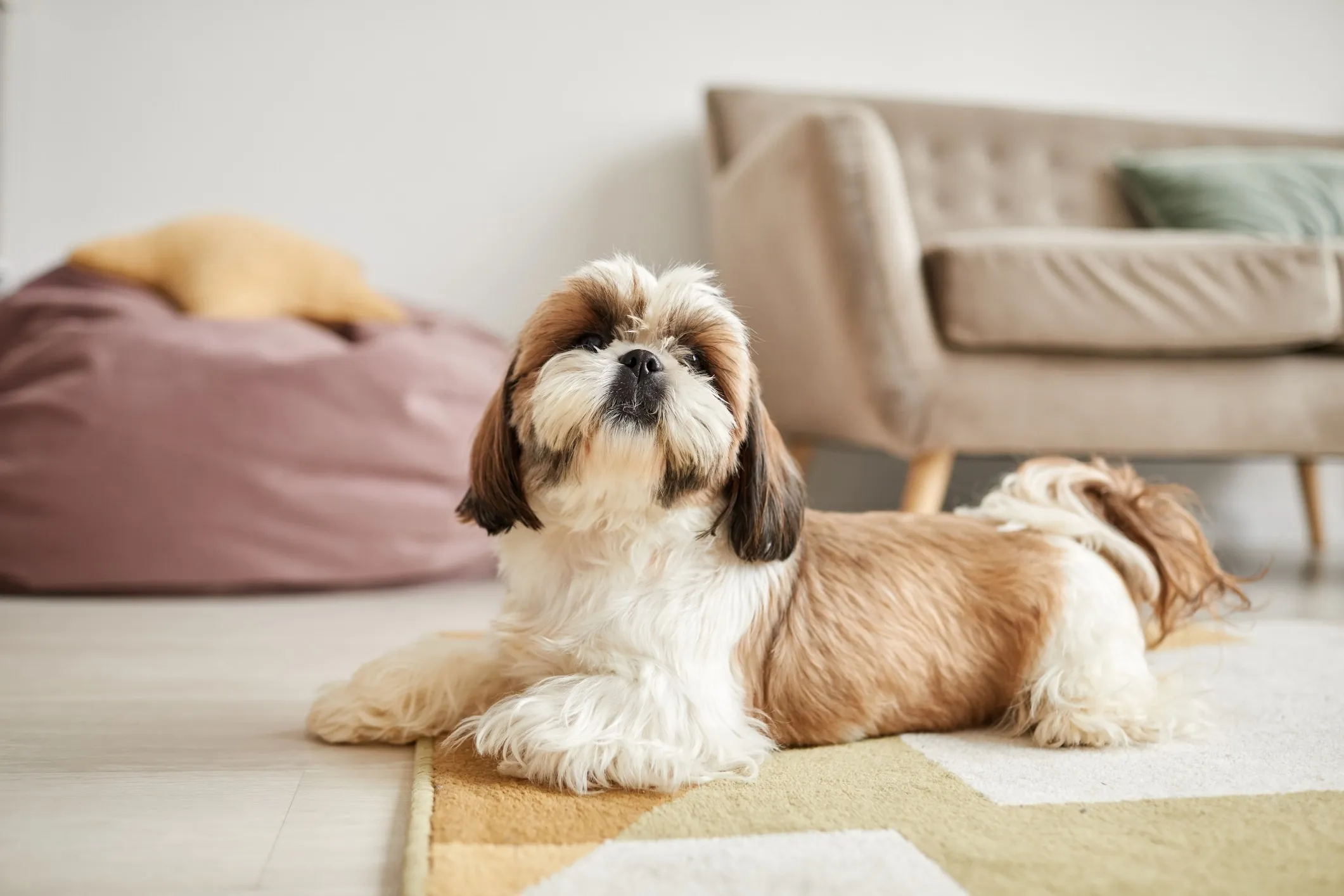 A brown and white Shih Tzu lies contentedly on a living room floor, displaying its thick, flowing coat.
A brown and white Shih Tzu lies contentedly on a living room floor, displaying its thick, flowing coat.
The Shih Tzu is an ancient companion breed renowned for its friendly temperament and luxurious, flowing coat that sheds very little. These small dogs were bred to be lap warmers and are characterized by their affectionate, outgoing, and playful nature, making them excellent family pets. They generally get along well with children and other pets. However, their flat faces mean they can be prone to certain health issues like overheating and breathing problems, so care must be taken in hot weather. Their long coat requires significant daily brushing and regular professional grooming to prevent matting and keep them comfortable. Despite their grooming demands, their cheerful disposition makes them a beloved choice for many homes.
4. Miniature Schnauzer
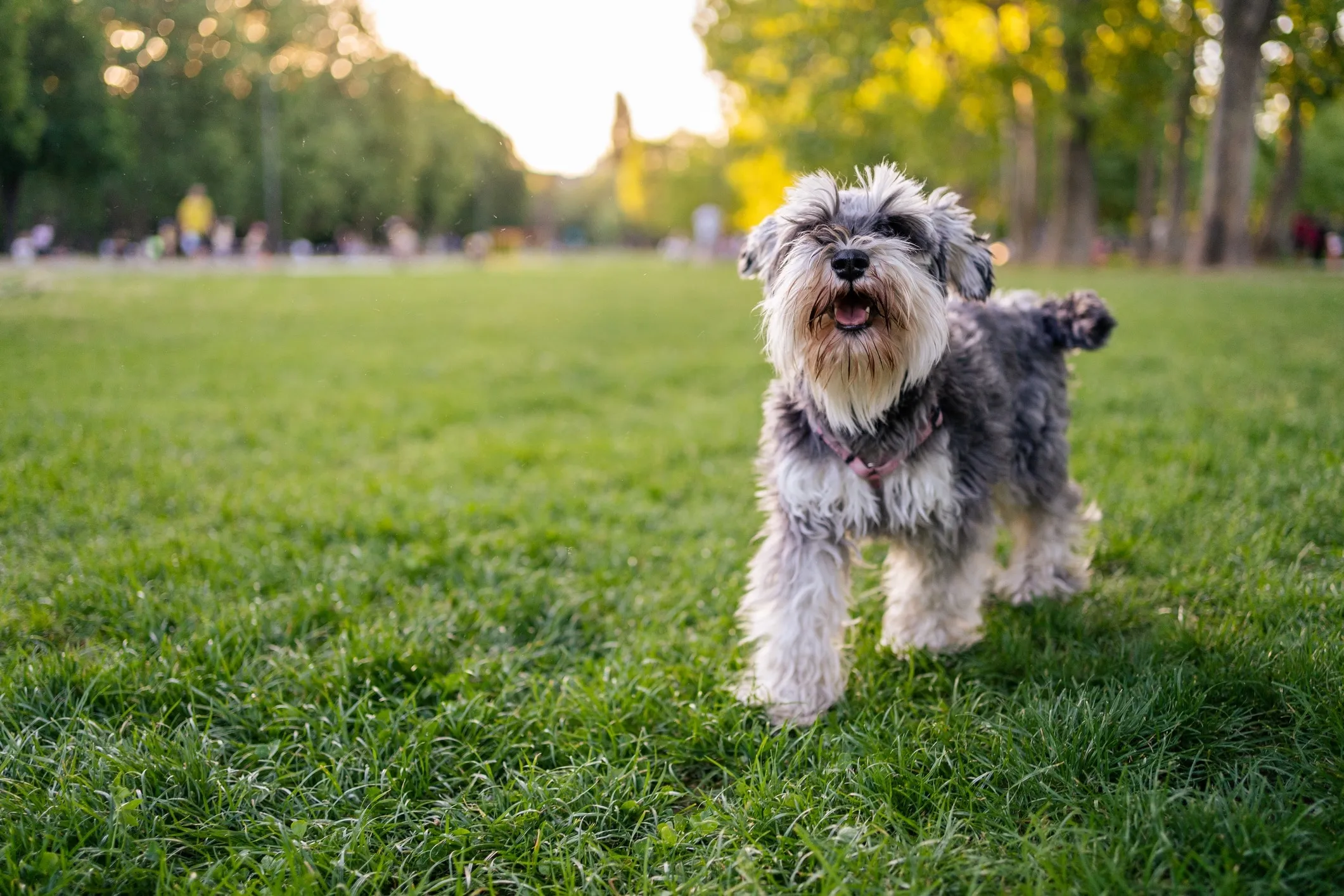 A salt and pepper Miniature Schnauzer wearing a pink harness stands attentively in a park, ready for adventure.
A salt and pepper Miniature Schnauzer wearing a pink harness stands attentively in a park, ready for adventure.
Compact, intelligent, and sturdy, the Miniature Schnauzer is a lively companion perfectly suited for family life. These spirited terriers are known for their distinctive wiry coat, which sheds minimally and is a great asset for allergy sufferers. Standing no more than 14 inches tall, they adapt well to various living environments, including urban apartments, provided they get at least an hour of exercise daily. Miniature Schnauzers are alert and protective, making them good watchdogs, and their playful nature ensures they’re fun companions for children. Consistent training and early socialization are important to channel their terrier energy positively. Their coat requires regular brushing and professional grooming (stripping or clipping) to maintain its texture and appearance.
5. Standard Schnauzer
 A gray Standard Schnauzer stands poised in a grassy field, its robust build and keen expression evident.
A gray Standard Schnauzer stands poised in a grassy field, its robust build and keen expression evident.
The Standard Schnauzer offers all the charm and intelligence of its miniature counterpart in a slightly larger, more robust package. Weighing up to 45 pounds, these dogs possess a similar wiry, low-shedding coat and a watchful, intelligent temperament. Standard Schnauzers are highly energetic and thrive on physical activity and mental stimulation. They love long walks, playing fetch, and engaging in puzzle toys, making them ideal for active families who can provide them with consistent exercise. They are loyal and protective of their family and generally good with children, especially with proper socialization. Their grooming needs are similar to the Miniature Schnauzer, requiring regular brushing and professional care.
6. Giant Schnauzer
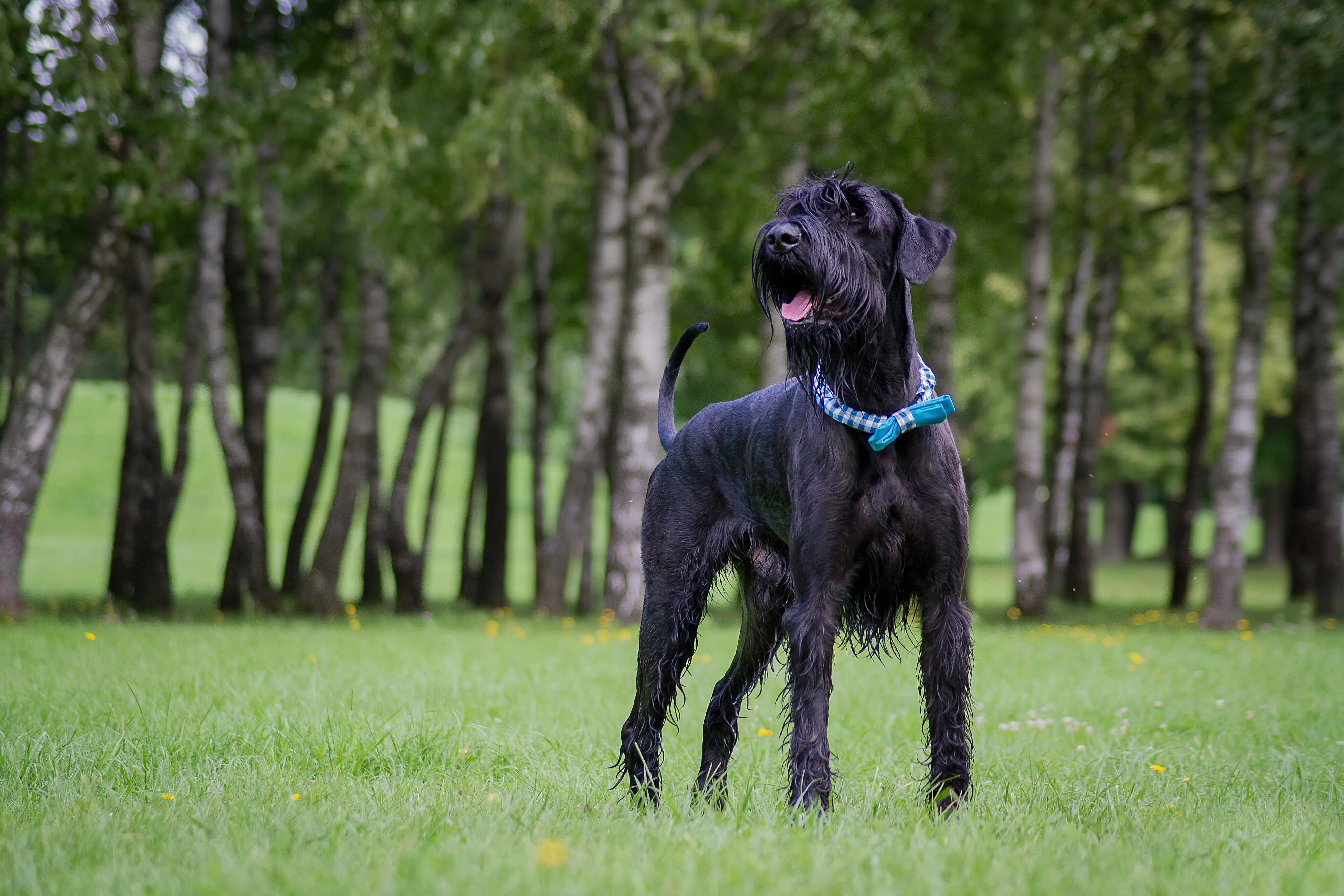 A black, wet Giant Schnauzer wearing a blue bow collar stands majestically in a park, showing its imposing presence.
A black, wet Giant Schnauzer wearing a blue bow collar stands majestically in a park, showing its imposing presence.
For families looking for a large, protective, and low-shedding companion, the Giant Schnauzer is an excellent choice. Capable of reaching over 27 inches in height and weighing up to 85 pounds, these dogs are among the biggest “hypoallergenic” breeds. They possess immense intelligence and loyalty, making them formidable yet loving family guardians. Giant Schnauzers require significant exercise, including long walks, runs, and hikes, to keep them happy and well-behaved. Their strong working drive means they excel in various dog sports and appreciate having a job to do. They form strong bonds with their family, including children, but their size and energy mean they are best suited for experienced dog owners who can provide firm, consistent training and plenty of activity.
7. Bichon Frise
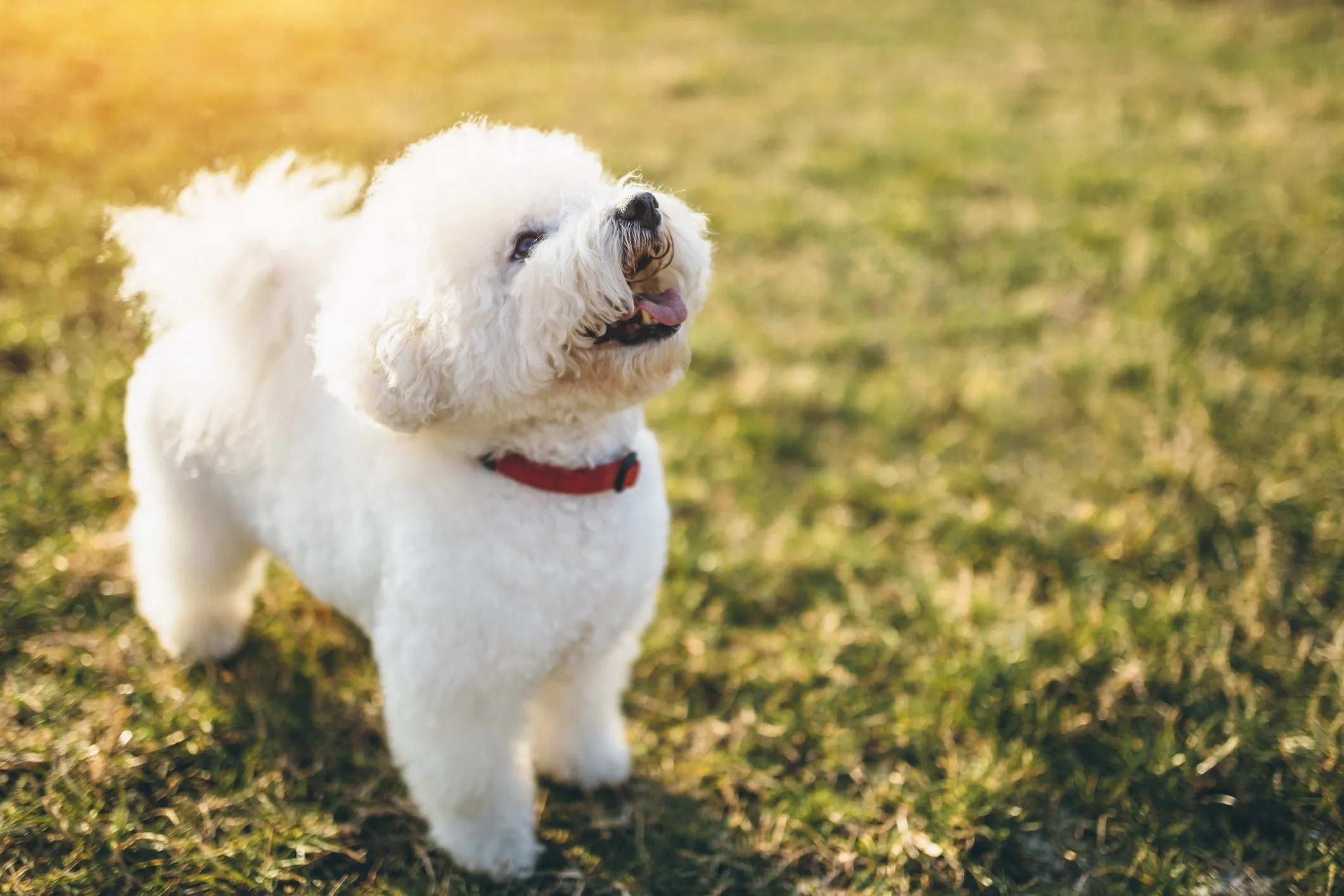 A fluffy white Bichon Frise looks up inquisitively while sitting in vibrant green grass.
A fluffy white Bichon Frise looks up inquisitively while sitting in vibrant green grass.
Small, playful, and incredibly affectionate, the Bichon Frise is a cheerful companion with a soft, curly, low-shedding coat. These charming dogs are known for their happy-go-lucky personalities and their ability to quickly master training basics with positive reinforcement. Bichons thrive on companionship and are excellent family dogs, generally getting along famously with children and other pets. Their moderate exercise needs can be met with daily walks and indoor play, making them suitable for apartment living. Regular grooming is crucial to prevent their soft curls from matting; daily brushing and professional grooming every few weeks are a must. The Bichon Frise’s sweet nature and low-shedding coat make them one of the most popular top 10 dog breeds that don’t shed for allergy-prone families.
8. Chinese Crested
 A black hairless Chinese Crested dog looks directly at the camera, showcasing its unique appearance.
A black hairless Chinese Crested dog looks directly at the camera, showcasing its unique appearance.
The Chinese Crested is a unique breed known for its distinctive appearance and minimal shedding. It comes in two varieties: the hairless, with smooth skin and tufts of hair on the head, tail, and paws, and the “powderpuff,” which is covered in a soft, silky coat. Both varieties are considered hypoallergenic. Chinese Cresteds are playful, affectionate, and make wonderful companion dogs. They are devoted to their families and can be surprisingly athletic despite their delicate appearance. Their small size makes them ideal for apartment living, and their moderate exercise needs are easily met. Hairless varieties require skin care (sunscreen, moisturizing), while powderpuffs need regular brushing. They generally do well with gentle, older children.
9. Portuguese Water Dog
 A black and white Portuguese Water Dog wears a red maple leaf bandana, standing alert near water.
A black and white Portuguese Water Dog wears a red maple leaf bandana, standing alert near water.
Originally bred as an aid to fishermen, the Portuguese Water Dog is a medium-sized, robust breed with a thick, curly, non-shedding coat. These intelligent and highly trainable dogs are known for their energetic and friendly nature, making them excellent family pets. They thrive on activity and love to swim, requiring significant regular exercise to stay happy and healthy. Their playful spirit and robust build make them great companions for active children. Portuguese Water Dogs bond closely with their families and need to be involved in household activities. Their dense coats require frequent brushing and regular professional grooming to prevent matting, especially if they are frequently in the water. For families seeking energetic medium to big dogs that don’t shed that love the outdoors, this breed is a fantastic option.
10. Labradoodle
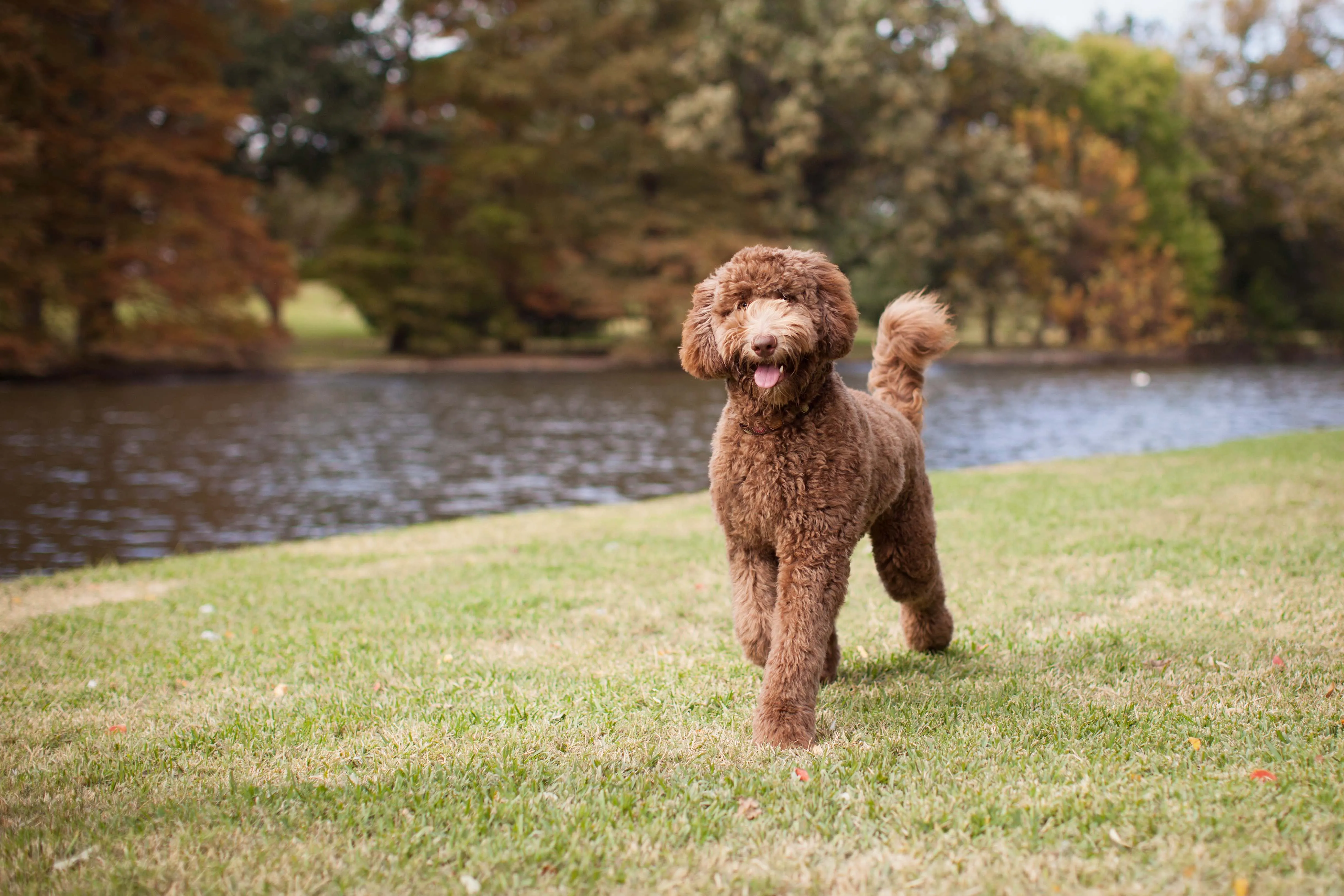 A brown Standard Labradoodle walks confidently in a park, displaying its curly, friendly appearance.
A brown Standard Labradoodle walks confidently in a park, displaying its curly, friendly appearance.
A delightful crossbreed between a Labrador Retriever and a Poodle, the Labradoodle was initially bred with the intention of creating a hypoallergenic service dog. They combine the friendly, outgoing nature of the Labrador with the intelligence and low-shedding coat of the Poodle. Labradoodles are known for being intelligent, gentle, and highly trainable, making them superb family pets. They are typically great with children and other animals, especially when socialized from an early age. Their energy levels vary, but most require daily exercise and mental stimulation to prevent boredom. The Labradoodle’s coat can range from wavy to curly and needs regular brushing and grooming to maintain its condition and prevent matting.
11. Goldendoodle
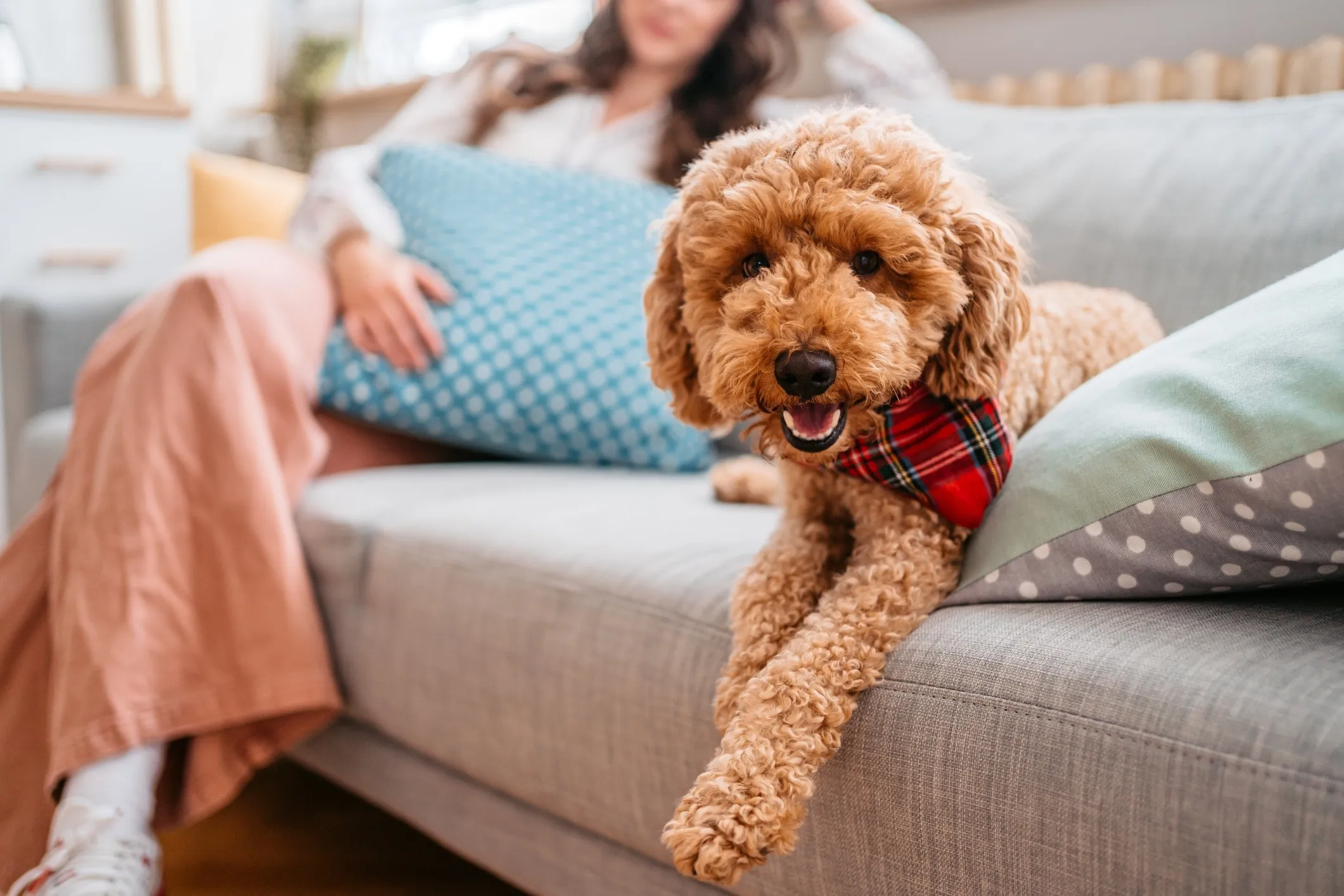 A Goldendoodle lies peacefully on a couch with a person sitting in the background, showing its calm demeanor.
A Goldendoodle lies peacefully on a couch with a person sitting in the background, showing its calm demeanor.
Another popular “doodle” breed, the Goldendoodle is a cross between a Golden Retriever and a Poodle. Like the Labradoodle, they are celebrated for their friendly nature, high intelligence, and low-shedding coats. Goldendoodles are affectionate, patient, and generally excellent with children, making them a fantastic addition to many families. Their energy levels range from moderate to high, requiring daily walks and playtimes to keep them content. While many are known for their golden coats, they can come in a variety of colors and textures. Frequent grooming with a dog slicker brush is essential to prevent their soft, wavy to curly coats from matting.
12. Lagotto Romagnolo
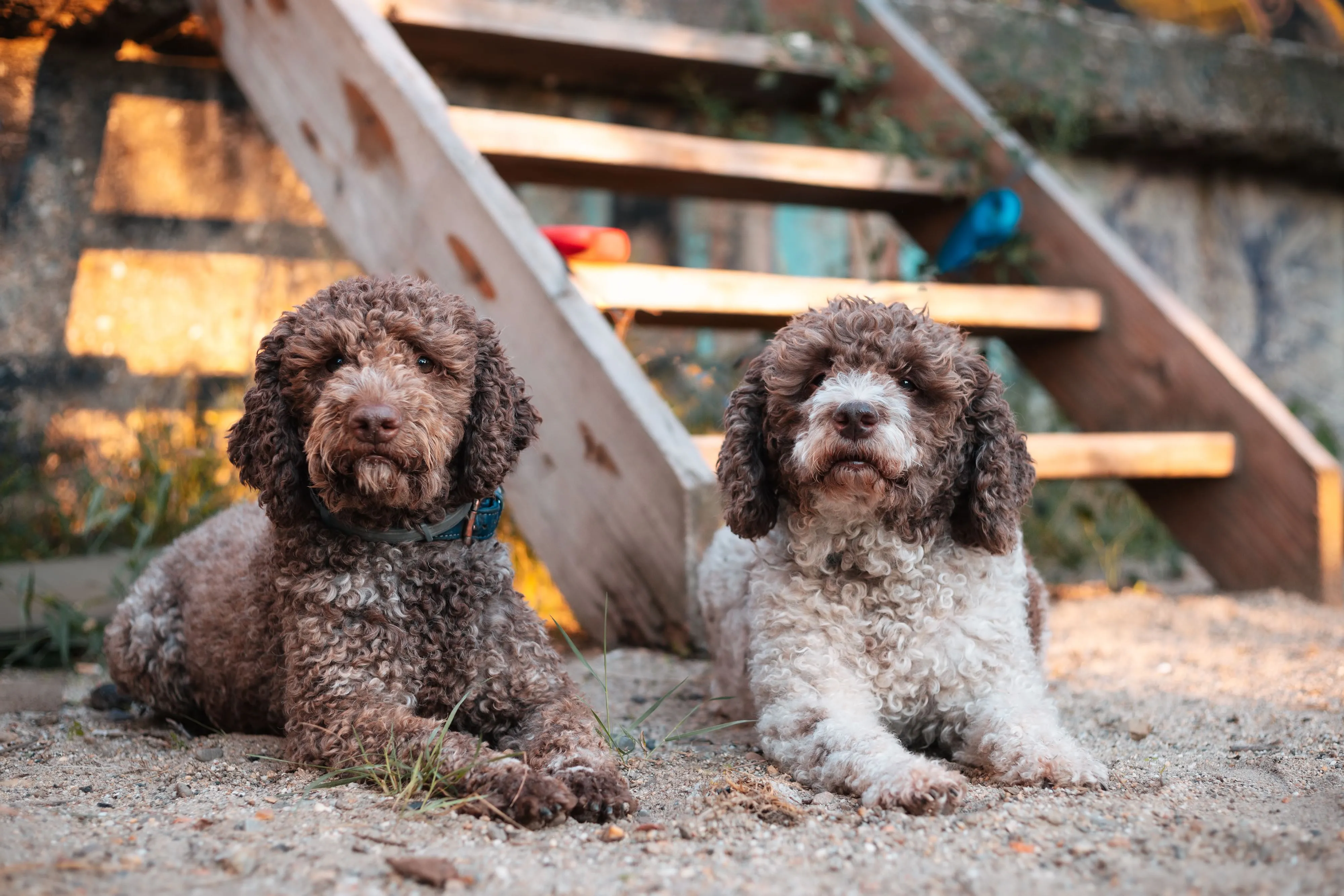 Two Lagotto Romagnolo dogs lie in the dirt, staring curiously at the camera, their curly coats showing.
Two Lagotto Romagnolo dogs lie in the dirt, staring curiously at the camera, their curly coats showing.
The Lagotto Romagnolo, an ancient Italian breed, was originally bred as a water retriever and truffle hunter. Their curly, woolly coat is not only protective in chilly waters but also sheds minimally, making them a good choice for families with allergies. Lagotti Romagnoli are known for being affectionate, intelligent, and highly trainable. They have a cheerful disposition and are generally good with children and other pets, especially with early socialization. This breed requires plenty of physical and mental exercise to satisfy their natural instincts for work and retrieval. Their unique coat needs regular brushing and occasional trimming to prevent matting.
13. Affenpinscher
 A close-up of a black Affenpinscher dog's face, highlighting its expressive, monkey-like features.
A close-up of a black Affenpinscher dog's face, highlighting its expressive, monkey-like features.
The Affenpinscher is a small, charming dog known for its distinctive monkey-like facial expression and dense, wiry coat. This unique coat produces fewer allergens than many other breeds, making them suitable for allergy sufferers. Affenpinschers are confident, curious, and often humorous companions. They are loyal to their families but can be quite opinionated and spirited. While generally good with older, respectful children, their small size means they might be overwhelmed by very young, boisterous kids. Their wiry coat requires consistent care, including at-home brushing and periodic hand-stripping by a professional groomer to maintain its texture and minimize shedding.
14. Irish Water Spaniel
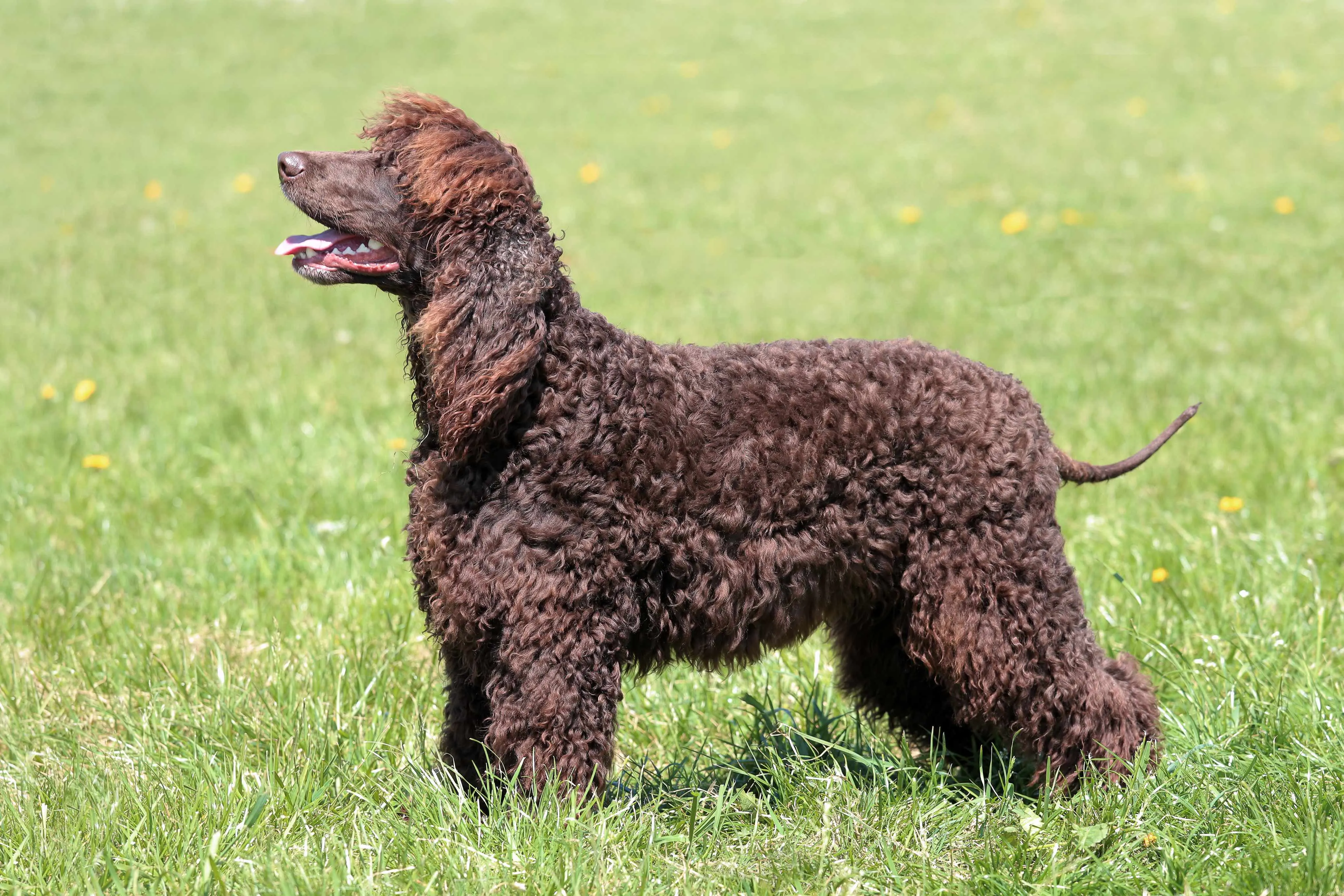 A brown Irish Water Spaniel is shown in profile, highlighting its unique curly coat and topknot.
A brown Irish Water Spaniel is shown in profile, highlighting its unique curly coat and topknot.
The Irish Water Spaniel is a distinguished and athletic breed, known for its friendly nature, high intelligence, and distinctive dense, curly coat that sheds minimally. These water dogs were originally bred for retrieving game and possess a high energy level, making regular exercise essential for their happiness and health. They are highly trainable and make excellent family pets for active households that can provide them with plenty of outdoor activities, including swimming. Their jovial and affectionate temperament ensures they get along well with children. Their liver-colored coat requires regular grooming, including brushing and occasional trimming, to keep it in good condition.
15. Aussiedoodle
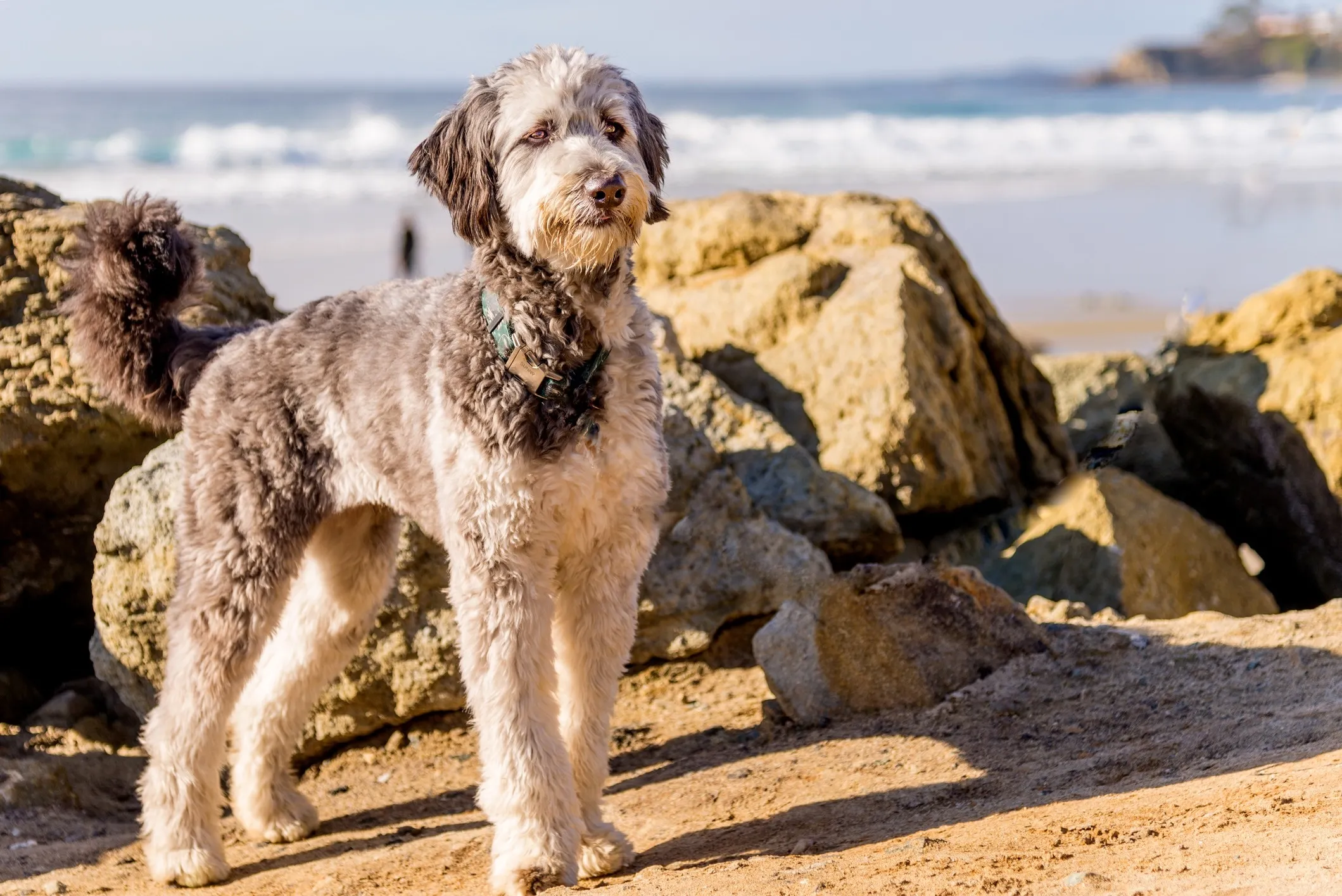 A standard Aussiedoodle dog stands gracefully on a beach, its fluffy coat contrasting with the sandy backdrop.
A standard Aussiedoodle dog stands gracefully on a beach, its fluffy coat contrasting with the sandy backdrop.
The Aussiedoodle is a vibrant cross between an Australian Shepherd and a Standard or Miniature Poodle, inheriting intelligence and a low-shedding coat from both parent breeds. These dogs are incredibly smart and energetic, requiring ample exercise and mental stimulation to prevent boredom and destructive behaviors. Aussiedoodles are known for their affectionate and playful personalities, making them wonderful companions for active families. They are generally good with children and other pets, thriving in environments where they are an integral part of family activities. Their wavy to curly coats need regular brushing and professional grooming to prevent matting and keep them looking their best. While Australian Shepherds are typically high-shedding, the Poodle influence helps make the Aussiedoodle a good option for those seeking a list of all Shepherd dog breeds with low-shedding characteristics.
16. Bolognese
 A white Bolognese dog sits attentively in an autumn forest, its fluffy coat creating a soft silhouette.
A white Bolognese dog sits attentively in an autumn forest, its fluffy coat creating a soft silhouette.
Hailing from Italy, the Bolognese is a charming and cute small dog with a long, fluffy white coat that sheds very little. These playful and easygoing pups are known for their sweet temperament and their ability to form strong bonds with their families. Bolognese dogs are typically good with children and other pets, making them adaptable to various living situations, from apartments to larger homes. They thrive on companionship and enjoy gentle play. Despite their characteristic “messy” appearance, their coat requires consistent grooming, including daily brushing, to prevent tangles and mats and keep them comfortable and clean.
17. Maltese
 A woman lovingly holds a small white Maltese dog on a bed, showcasing its luxurious long hair.
A woman lovingly holds a small white Maltese dog on a bed, showcasing its luxurious long hair.
The Maltese is a regal yet playful small dog known for its luxurious, silky white coat that sheds minimally. These affectionate and gentle companions thrive on human interaction and make devoted family members. Maltese dogs are generally good with children, particularly older ones who understand how to handle a small, delicate dog. They have moderate exercise needs that can be met with indoor play and short daily walks. While their long coat is beautiful, it requires significant grooming, including daily brushing, to prevent matting. Many Maltese owners opt for a shorter “puppy cut” to make grooming more manageable.
18. Soft Coated Wheaten Terrier
 A Soft Coated Wheaten Terrier dog sits calmly on a log, its silky coat glowing in the sunlight.
A Soft Coated Wheaten Terrier dog sits calmly on a log, its silky coat glowing in the sunlight.
The Soft Coated Wheaten Terrier is a medium-sized Irish breed distinguished by its incredibly soft, silky coat that sheds minimally. True to their terrier heritage, Wheatens maintain a high energy level throughout their lives and require ample exercise and mental stimulation to be well-behaved and happy. They are known for their joyful “Wheaten Greetin'” where they jump up to welcome their loved ones. Wheatens are generally friendly and playful, making them great companions for active families with children. Their unique coat needs regular brushing and professional grooming to prevent matting and keep it clean and soft.
19. Coton de Tulear
 A white Coton de Tulear sits in tall grass, its fluffy hair gently blowing in the wind.
A white Coton de Tulear sits in tall grass, its fluffy hair gently blowing in the wind.
Originating from Madagascar, the Coton de Tulear is a small, charming breed known for its soft, cotton-like coat that is low-shedding. Cotons are easygoing, playful, and incredibly affectionate, thriving on human companionship. Their good nature makes them a good fit for families with children and other pets, especially when properly introduced and socialized. They have moderate exercise needs, enjoying daily walks and playtime. This breed’s unique coat, while low-shedding, requires daily brushing to prevent tangles and mats, ensuring their comfort and maintaining their distinctive appearance.
20. Schnoodle
 A close-up of a gray Schnoodle dog's face, showing its curly fur and expressive eyes.
A close-up of a gray Schnoodle dog's face, showing its curly fur and expressive eyes.
The Schnoodle is a delightful cross between two low-shedding breeds: the Schnauzer and the Poodle. This combination often results in a dog with a low-shedding, curly or wavy coat, depending on the parents’ genetics. Schnoodles are known for their intelligence, playful spirit, and affectionate nature, making them wonderful family companions. They are generally good with children and adapt well to various living situations, provided they receive consistent exercise and mental stimulation. Their temperament can vary, but most are lively and eager to please. Regular grooming, including brushing and occasional clipping, is necessary to keep their coats in prime condition.
21. Bedlington Terrier
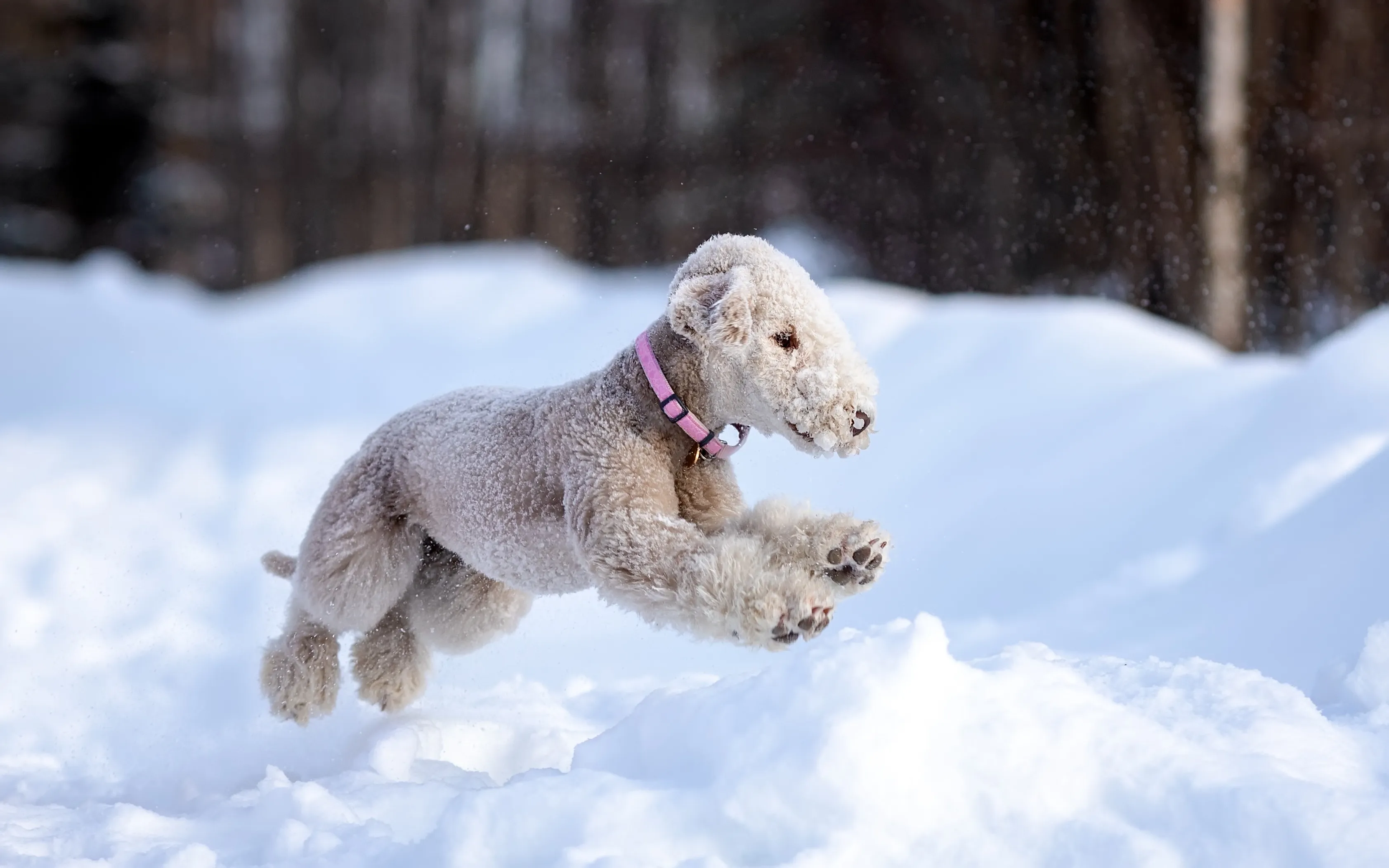 A white Bedlington Terrier runs gracefully through the snow, its distinctive lamb-like appearance visible.
A white Bedlington Terrier runs gracefully through the snow, its distinctive lamb-like appearance visible.
Often described as “a lamb in dog’s clothing,” the Bedlington Terrier is a small, unique breed with a curly, low-shedding coat. They are known for their distinctive topknot hairdo and pom-pom ear tufts. Bedlingtons are affectionate and loyal, thriving on being close to their people. They can develop separation anxiety if left alone for extended periods, making them best suited for families where someone is usually home. Despite their gentle appearance, they have a terrier’s energy and require daily exercise. They are generally good with children and make playful family members. Their special coat requires regular professional grooming and occasional hand-stripping to maintain its characteristic texture and appearance.
22. Xoloitzcuintli (Mexican Hairless Dog)
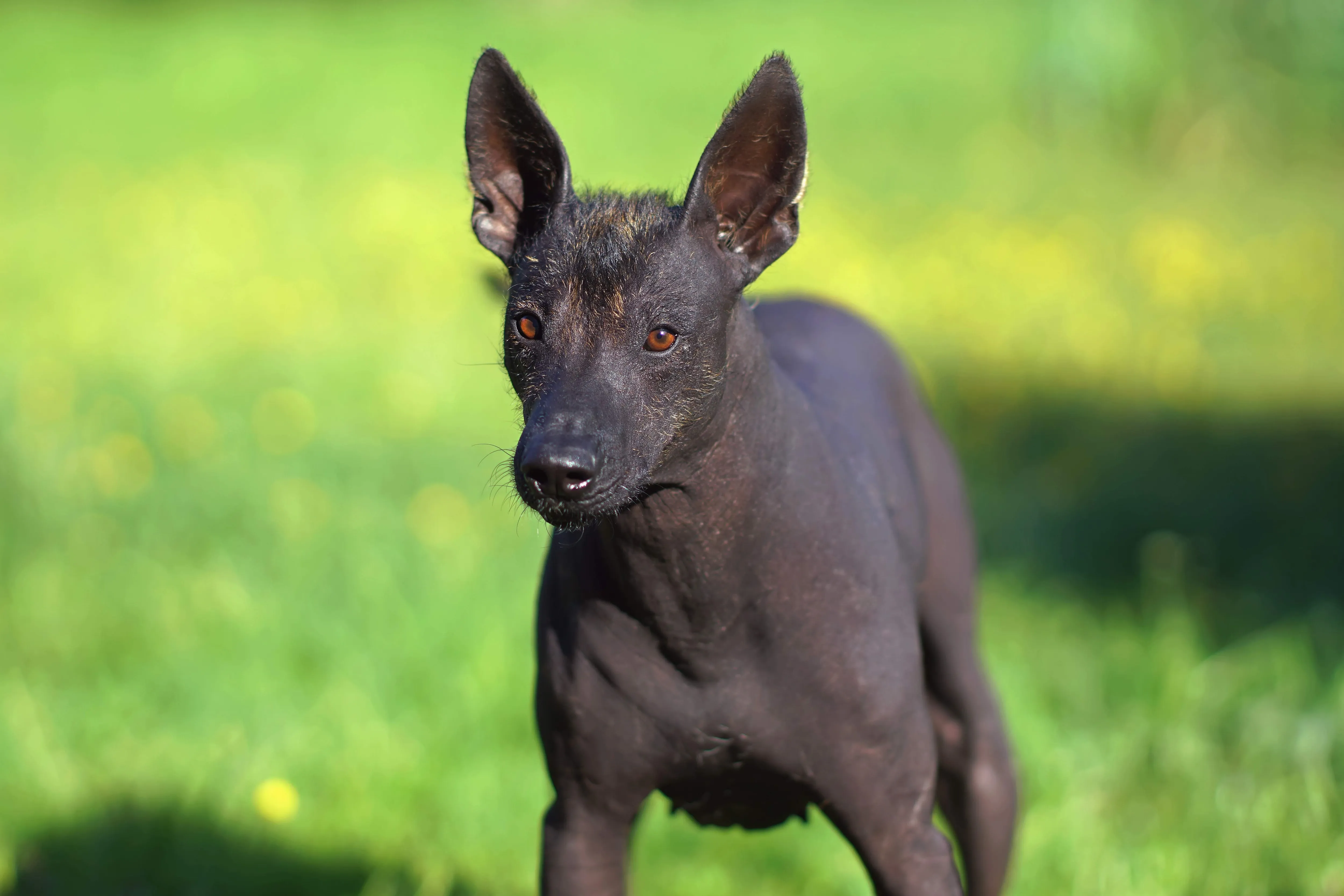 A black Mexican Hairless Dog (Xoloitzcuintli) stands alertly in the grass, showcasing its unique hairless body.
A black Mexican Hairless Dog (Xoloitzcuintli) stands alertly in the grass, showcasing its unique hairless body.
One of the oldest and rarest dog breeds, the Xoloitzcuintli (pronounced Sho-lo-eets-kweent-lee) is naturally low-shedding due to its hairless or very short-coated varieties. Available in toy, miniature, and standard sizes, Xolos are calm, alert, and fiercely loyal to their families. They are typically good with children and make protective yet gentle companions. While the hairless variety requires skin care (sunscreen, moisturizing, protection from cold), the coated variety needs minimal grooming. Their exercise needs are moderate, making them adaptable to different family lifestyles. Their unique nature makes them a fascinating and allergy-friendly choice.
23. Whoodle
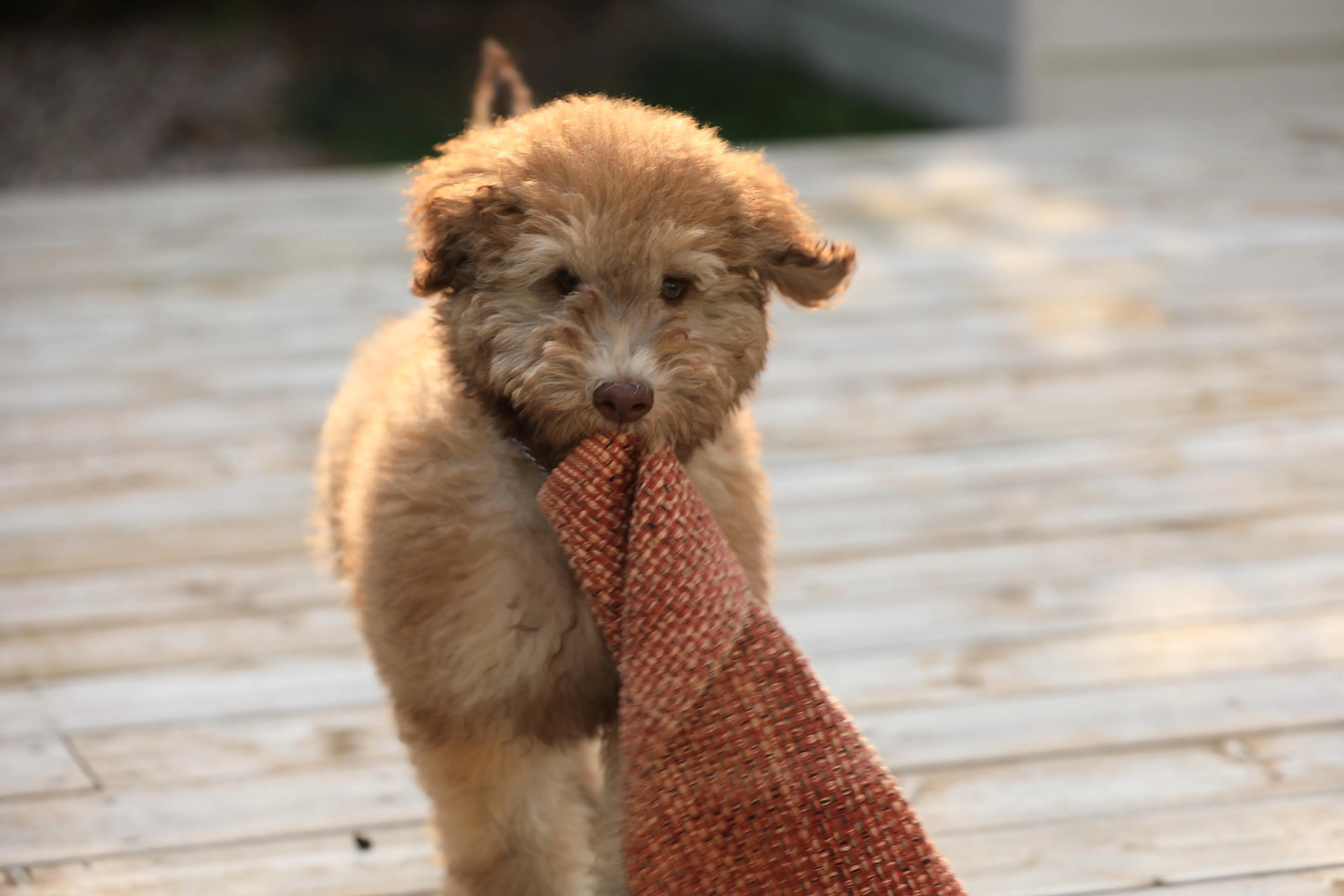 A tan Whoodle puppy playfully drags a washcloth, showing its soft, fluffy coat.
A tan Whoodle puppy playfully drags a washcloth, showing its soft, fluffy coat.
The Whoodle is a charming cross between a Soft-Coated Wheaten Terrier and a Poodle, resulting in a friendly dog that sheds very little. Whoodles inherit intelligence and an affectionate nature from both parent breeds, making them highly desirable family pets. They are typically playful and good-natured, getting along well with children and other animals. Whoodles are energetic and require daily exercise, enjoying activities like walks, playtime, and engaging in dog sports. Their soft, wavy to curly coats need regular brushing and professional grooming to prevent matting and keep them comfortable.
24. Bernedoodle
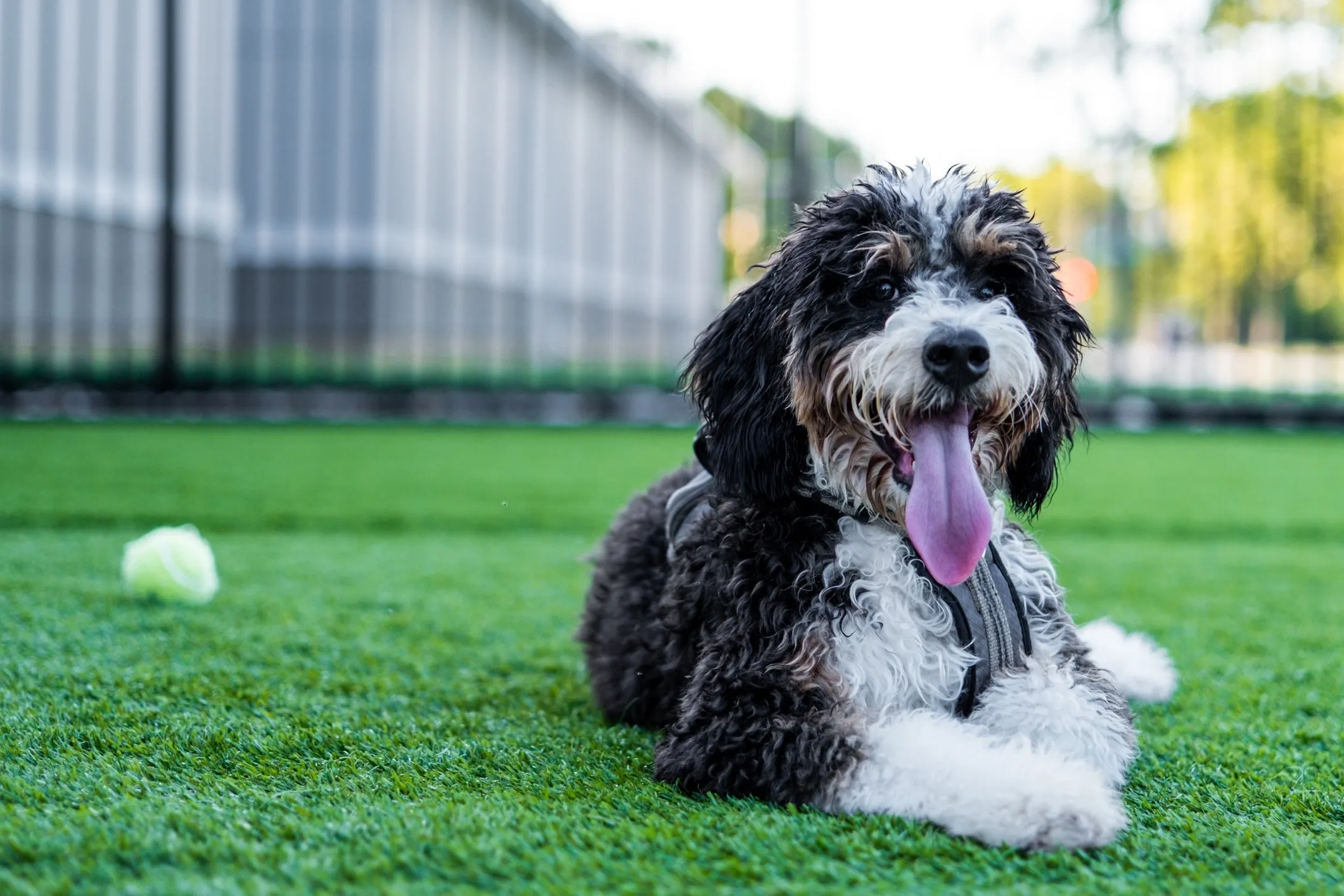 A large Bernedoodle dog lies relaxed in the grass with its tongue out, displaying its friendly demeanor.
A large Bernedoodle dog lies relaxed in the grass with its tongue out, displaying its friendly demeanor.
For families seeking a large family dogs that don’t shed, the Bernedoodle, a cross between a Bernese Mountain Dog and a Poodle, is an increasingly popular choice. These gentle giants are known for their friendly, affectionate nature and patient demeanor, making them excellent companions for families with children and other pets. They combine the loyalty and calm disposition of the Bernese with the intelligence and low-shedding coat of the Poodle. Bernedoodles require moderate to high levels of exercise to stay happy and healthy. Their wavy or curly coats need consistent brushing and professional grooming to prevent tangles and mats.
25. Shorkie
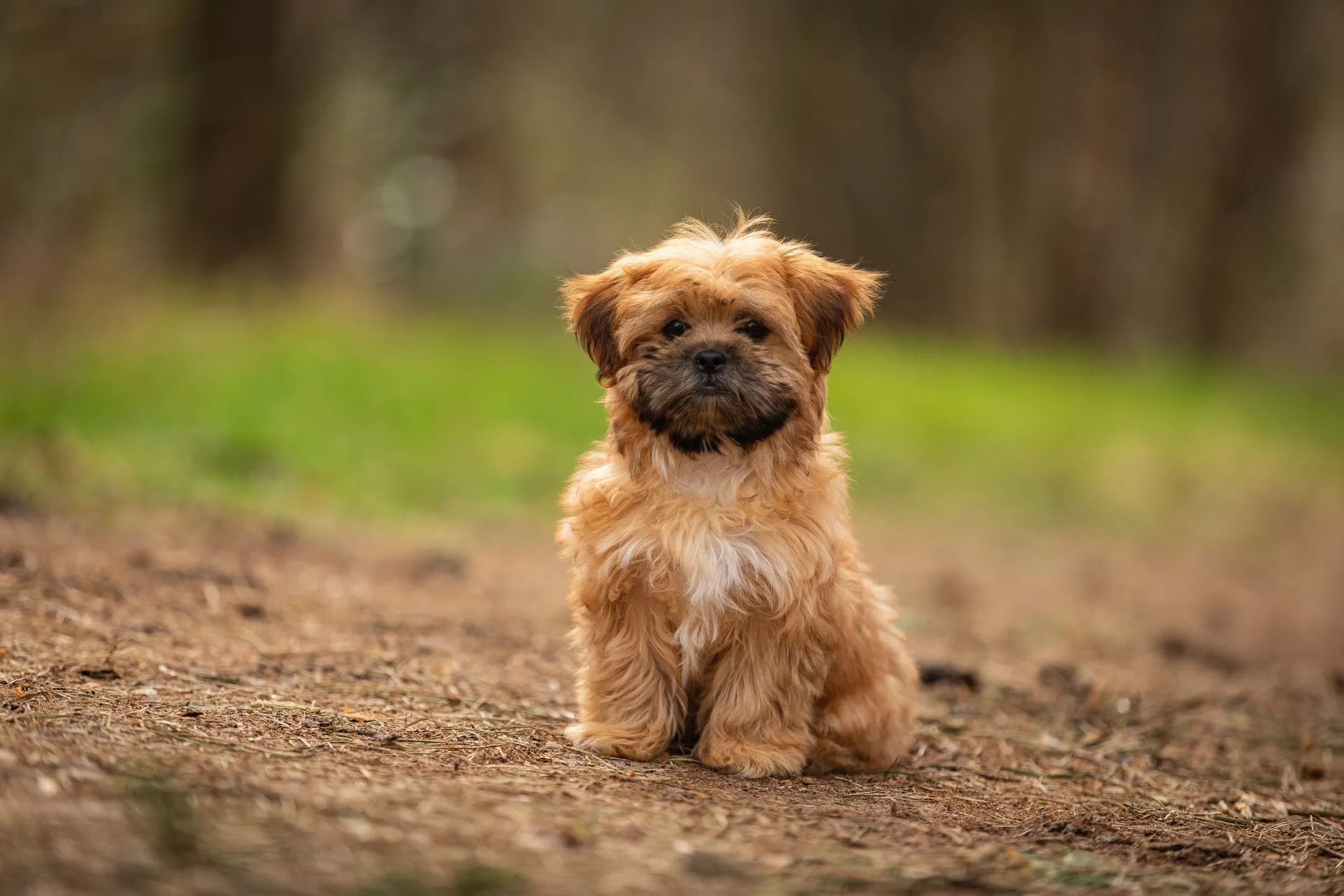 A tan and black Shih Tzu and Yorkie mix (Shorkie) sits attentively on a hiking trail.
A tan and black Shih Tzu and Yorkie mix (Shorkie) sits attentively on a hiking trail.
The Shorkie is a delightful mixed breed combining two low-shedding dogs: the Shih Tzu and the Yorkshire Terrier. This cross results in a small, playful, and friendly companion that embodies the best traits of both parent breeds. Shorkies are affectionate and thrive on close companionship, making them ideal for families who can provide lots of attention. They adapt well to apartment living and have moderate exercise needs. Like most low-shedding breeds, Shorkies require a dedicated regular grooming routine, including daily brushing, to keep their long, silky coats free from tangles and mats.
26. Afghan Hound
 A gray and tan Afghan Hound looks directly at the camera, its long, flowing coat a prominent feature.
A gray and tan Afghan Hound looks directly at the camera, its long, flowing coat a prominent feature.
Known for their striking appearance with long, flowing coats and slender builds, Afghan Hounds are surprisingly low-shedding once their adult coat comes in. These elegant dogs are built for speed and possess a unique combination of aloof dignity and affectionate loyalty towards their families. While they can be reserved with strangers, early and consistent socialization is crucial for this breed to ensure they are well-adjusted family members. Afghan Hounds require significant exercise, including regular running, to satisfy their athletic nature. Their luxurious coat demands extensive daily grooming to prevent matting and maintain its pristine condition, making them a commitment for dedicated owners.
27. Barbet
 A close-up of a curly red Barbet dog's face, highlighting its shaggy, woolly texture and characteristic beard.
A close-up of a curly red Barbet dog's face, highlighting its shaggy, woolly texture and characteristic beard.
The Barbet, pronounced “bar-bay,” is a cheerful and robust French water dog with a shaggy, woolly coat that sheds minimally. The breed’s name comes from the French word for “beard,” a nod to its characteristic hairy chin. Barbets are known for their friendly, intelligent, and even-tempered personalities, making them wonderful family companions. They love to swim and need plenty of exercise, making them ideal for active families who enjoy outdoor activities. Their protective curly coat helps them thrive in water. To keep their coat in good condition, especially after swimming, regular brushing with a slicker or pin brush two to three times a week is essential to prevent matting.
28. Shih-Poo
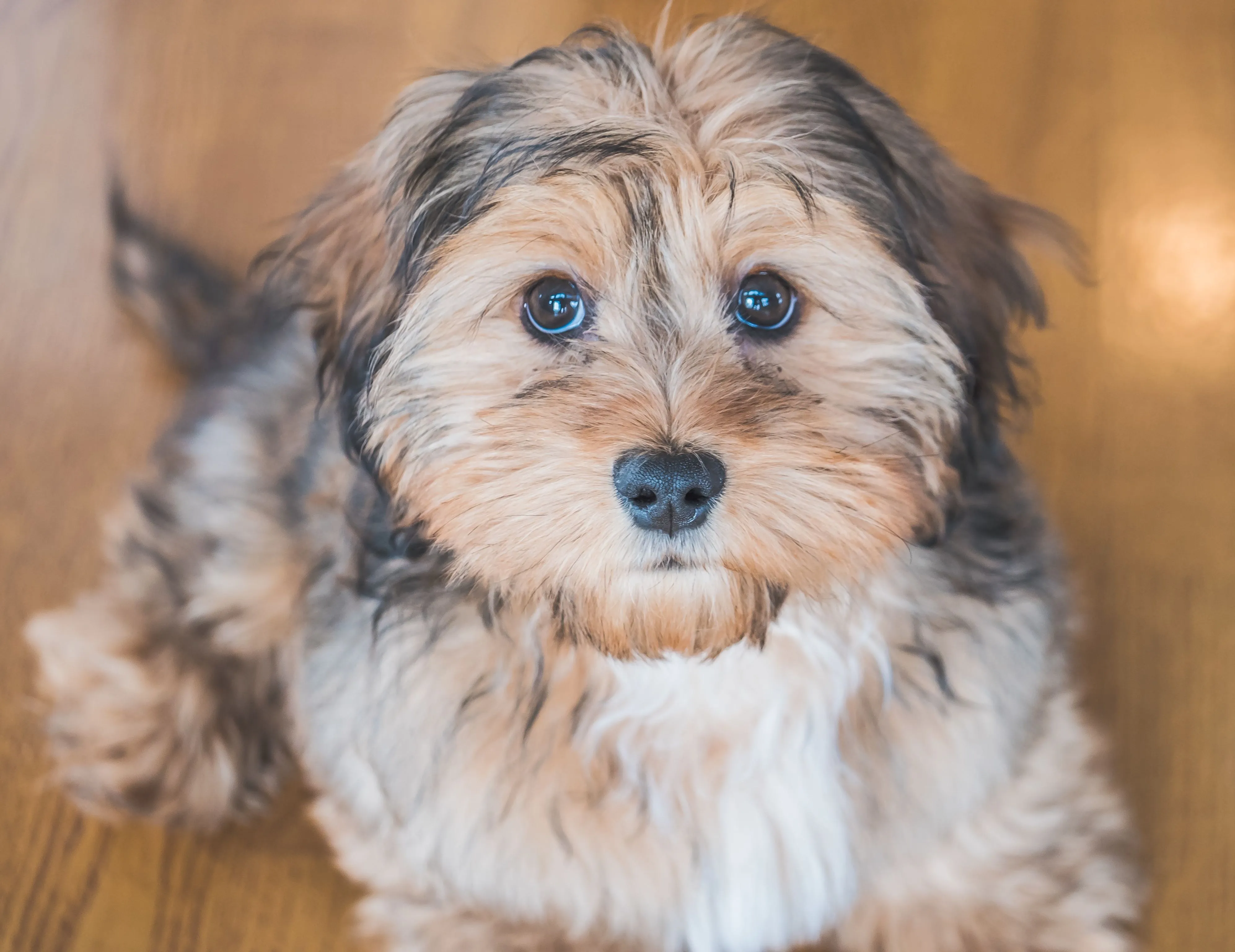 A close-up of a tan and black Shih-Poo dog's face, showing its fluffy, expressive features.
A close-up of a tan and black Shih-Poo dog's face, showing its fluffy, expressive features.
The Shih-Poo is a charming mixed breed, typically a cross between a Shih Tzu and a Toy Poodle. This small pup combines the playful and affectionate nature of both parent breeds with a low-shedding coat. Shih-Poos are highly adaptable and can thrive in almost any living situation, from apartments to larger homes, as long as they receive about 30 minutes of exercise and a good brushing session every day. They are generally good with children and other pets, making them delightful family companions. Their soft, wavy to curly coat requires regular grooming to keep it tangle-free and healthy.
29. Peruvian Inca Orchid
 A Peruvian Inca Orchid dog stands gracefully, displaying its almost hairless body.
A Peruvian Inca Orchid dog stands gracefully, displaying its almost hairless body.
The Peruvian Inca Orchid, the national dog of Peru, is a rare and ancient breed known for its nearly hairless body, making it an excellent hypoallergenic choice. This breed comes in three sizes (small, medium, and large) and also has a coated variety with a very short single coat. Both types are low-shedding. Peruvian Inca Orchids are elegant, alert, and highly affectionate with their families, though they can be reserved with strangers. They make loyal and gentle companions and are generally good with respectful children. Their skin requires protection from the sun and cold, while the coated variety needs minimal grooming.
30. Malshi
 A tricolor Malshi dog sits attentively in green grass, its fluffy coat creating a soft outline.
A tricolor Malshi dog sits attentively in green grass, its fluffy coat creating a soft outline.
The Malshi is a joyful and small mixed breed resulting from a cross between a Maltese and a Shih Tzu. This combination creates a charming, low-shedding companion that thrives on close companionship and human interaction. Malshis are known for their happy, outgoing personalities and are typically good with children and other pets, making them excellent family additions. They adapt well to various living environments, including apartments, and have moderate exercise needs. Like their parent breeds, Malshis require regular grooming, including daily brushing, to keep their long, soft coats free from tangles and mats.
Essential Tips for Living with a Low-Shedding Dog
While choosing a low-shedding breed is a great start, maintaining a harmonious, allergy-friendly home also involves consistent care and attention.
Regular Grooming is Key
Even low-shedding dogs require diligent grooming to minimize allergens. Their hair continues to grow, trapping dander and loose hairs close to the skin. Regular brushing helps remove these irritants before they can disperse into your home. Most low-shedding breeds benefit from daily or every-other-day brushing and professional grooming every 4-8 weeks. Bathing your dog every 4-6 weeks with a gentle, hypoallergenic shampoo can also help wash away dander and allergens. Consider using specialized products like dander removers for an extra layer of protection. If you plan to groom at home, ensure you have the right tools and techniques, or budget for professional grooming services.
Maintaining a Clean Home Environment
Beyond grooming your dog, keeping your home clean is crucial for managing allergens. Establish a routine for vacuuming, dusting, and washing bedding (both yours and your dog’s) regularly to minimize the accumulation of pet dander. Using a vacuum cleaner with a HEPA filter can effectively capture allergens. Air purifiers can also help reduce airborne allergens, and good ventilation in your home is always beneficial. Consider creating “allergy-free zones” in your home, such as bedrooms, where your dog is not allowed, to provide a respite for allergy sufferers.
Consulting with Your Doctor and Veterinarian
For families with severe allergies, it’s always wise to consult with both your healthcare provider and your veterinarian before bringing a new dog home. Your doctor can offer advice on allergy management, including medications, nasal sprays, or immunotherapy, to help mitigate potential reactions. Your veterinarian can provide guidance on specific breed characteristics, grooming requirements, and overall pet care to ensure your dog stays healthy and happy. They can also advise on avoiding close contact with dog saliva or urine, as these can also trigger allergic reactions in sensitive individuals.
Conclusion
Choosing a family dog is a significant decision, and for those managing allergies, selecting a low-shedding breed can open the door to the wonderful world of canine companionship without compromising health. The breeds listed above offer a fantastic combination of low-shedding coats and family-friendly temperaments, ensuring there’s a perfect furry friend for nearly every household. From the intelligent Poodle to the charming Bernedoodle, these dogs prove that you don’t have to sacrifice joy for comfort. By understanding their specific needs, committing to regular grooming, and maintaining a clean home, families with allergy concerns can truly experience the boundless love and happiness a dog brings.
Ready to find your perfect low-shedding companion? Explore more guides and tips on Dog Care Story to ensure your new family member thrives!
